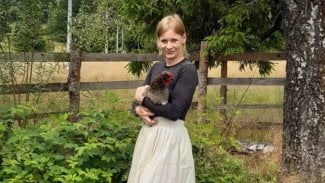gvpr
NAME
gvpr - graph pattern scanning and processing language
( previously known as gpr )
( previously known as gpr )
SYNOPSIS
gvpr
[-icV?]
[
I -o
outfile
]
[
I -a
args
]
[
'prog'
|
I -f
progfile
]
[
files
]
DESCRIPTION
gvpr
is a graph stream editor inspired by awk.
It copies input graphs to its
output, possibly transforming their structure and attributes,
creating new graphs, or printing arbitrary information.
The graph model is that provided by
R libagraph (3).
In particular, gvpr reads and writes graphs using the
dot language.
Basically,
gvpr
traverses each input graph, denoted by $G, visiting each node and edge,
matching it with the predicateaction rules supplied in the input program.
The rules are evaluated in order.
For each predicate evaluating to true, the corresponding
action is performed.
During the traversal, the current node or edge being visited
is denoted by $.
For each input graph, there is a target subgraph, denoted by
$T, initially empty and used to accumulate
chosen entities, and an output graph, $O, used for final processing
and then written to output.
By default, the output graph is the target graph.
The output graph can be set in the program or, in a limited sense,
on the command line.
OPTIONS
The following options are supported:
I -a args
The string args is split into whitespaceseparated tokens,
with the individual tokens
available as strings in the gvpr program
as ARGV[0],...,ARGV[ARGC-1].
Whitespace characters within single or double quoted substrings, or
preceded by a backslash, are ignored as separators.
In general, a backslash character turns off any special meaning of the
following character.
Note that the tokens derived from multiple -a flags are concatenated.
-c
Use the source graph as the output graph.
-i
Derive the nodeinduced subgraph extension of the output graph in the context
of its root graph.
I -o outfile
Causes the output stream to be written to the specified file; by default,
output is written to stdout.
I -f progfile
Use the contents of the specified file as the program to execute
on the input. If progfile contains a slash character, the name is taken
as the pathname of the file. Otherwise, gvpr will use the
directories specified in the environment variable GPRPATH to look
for the file. If
-f
is not given,
gvpr
will use the first nonoption argument as the program.
-V
Causes the program to print version information and exit.
-?
Causes the program to print usage information and exit.
OPERANDS
The following operand is supported:
files
Names of files containing 1 or more graphs in the dot language.
If no
-f
option is given, the first name is removed from the list and used
as the input program. If the list of files is empty, stdin will be used.
PROGRAMS
A
gvpr
program consists of a list of predicateaction clauses, having one
of the forms:
I BEGIN { action }
I BEG_G { action }
I N [ predicate ] { action }
I E [ predicate ] { action }
I END_G { action }
I END { action }
A program can contain at most one of each of the BEGIN, BEG_G,
END_G and END clauses.
There can be any number of N and E statements,
the first applied to nodes, the second to edges.
The toplevel semantics of a gvpr program are:
Evaluate the BEGIN clause, if any.
For each input graph G {
Set G as the current graph and current object.
Evaluate the BEG_G clause, if any.
For each node and edge in G {
Set the node or edge as the current object.
Evaluate the N or E clauses, as appropriate.
}
Set G as the current object.
Evaluate the END_G clause, if any.
}
Evaluate the END clause, if any.
The actions of the BEGIN, BEG_G, END_G and END clauses
are performed when the clauses are evaluated.
For N or E clauses,
either the predicate or action may be omitted.
If there is no predicate with an action, the action is
performed on every node or edge, as appropriate.
If there is no action and the predicate evaluates to true,
the associated node or edge is added to the target graph.
Predicates and actions are sequences of statements in the C dialect
supported by the
R libexpr (3)
library.
The only difference between predicates and actions is that the former
must have a type that may interpreted as either true or false.
Here the usual C convention is followed, in which a nonzero value is
considered true. This would include nonempty strings and nonempty
references to nodes, edges, etc. However, if a string can be
converted to an integer, this value is used.
In addition to the usual C base types
(void, int, char, float, long,
unsigned and double),
gvpr provides string as a synonym for char*, and
the graphbased types node_t,
edge_t, graph_t and obj_t.
The obj_t type can be viewed as a supertype of the other 3 concrete types;
the correct base type is maintained dynamically.
Besides these base types, the only other supported type expressions
are (associative) arrays.
Constants follow C syntax, but strings may be quoted with either
"..." or '...'. In certain contexts, string values are
interpreted as patterns for the purpose of regular expression matching.
Patterns use
R ksh (1)
file match pattern syntax.
gvpr accepts C++ comments as well as cpptype comments.
For the latter, if a line begins with a '#' character, the rest of
the line is ignored.
A statement can be a declaration of a function, a variable
or an array, or an executable statement. For declarations, there
is a single scope. Array declarations have the form:
type array [ var ]
where the var is optional. As in C, variables and arrays must
be declared. In particular, an undeclared variable will be interpreted
as the name of an attribute of a node, edge or graph, depending on the
context.
Executable statements can be one of the following:
{ [ statement ... ] }
expression // commonly var = expression
if( expression ) statement [ else statement ]
for( expression ; expression ; expression ) statement
for( array [ var ]) statement
while( expression ) statement
switch( expression ) case statements
break [ expression ]
continue [ expression ]
return [ expression ]
Items in brackets are optional.
In the second form of the for statement, the variable var
is set to each value used as an index in the specified array and then
the associated statement is evaluated. Function definitions can
only appear in the BEGIN clause.
Expressions include the usual C expressions.
String comparisons using == and !=
treat the right hand operand as a pattern.
gvpr will attempt to use an expression as a string or numeric value
as appropriate.
Expressions of graphical type (i.e., graph_t, node_t,
edge_t, obj_t) may be followed by a field reference in the
form of .name. The resulting value is the value
of the attribute named name of the given object.
In addition, in certain contexts an undeclared, unmodified
identifier is taken to be an
attribute name. Specifically, such identifiers denote attributes
of the current node or edge, respectively, in N
and E clauses, and the current graph in BEG_G and END_G
clauses.
As usual in the
R libagraph (3)
model, attributes are stringvalued.
In addition,
gvpr
supports certain pseudoattributes of graph objects, not necessarily
stringvalued. These reflect intrinsic properties of the graph objects
and cannot be set by the user.
head : node_t
the head of an edge.
tail : node_t
the tail of an edge.
name : string
the name of an edge, node or graph. The name of an edge has the
form "<tailname><edgeop><headname>[<key>]",
where <edgeop> is "->" or "--" depending on
whether the graph is directed or not. The bracket part [<key>]
only appears if the edge has a nontrivial key.
indegree : int
the indegree of a node.
outdegree : int
the outdegree of a node.
degree : int
the degree of a node.
root : graph_t
the root graph of an object. The root of a root graph
is itself.
parent : graph_t
the parent graph of a subgraph. The parent of a root graph
is NULL
n_edges : int
the number of edges in the graph
n_nodes : int
the number of nodes in the graph
directed : int
true (nonzero) if the graph is directed
strict : int
true (nonzero) if the graph is strict
BUILTIN FUNCTIONS
The following functions are built into gvpr. Those functions
returning references to graph objects return NULL in case of failure.
Graphs and subgraph
graph(s : string, t : string) : graph_t
creates a graph whose name is s and whose type is
specified by the string t. Ignoring case, the characters
U, D, S, N have the interpretation undirected, directed,
strict, and nonstrict, respectively. If t is empty,
a directed, nonstrict graph is generated.
subg(g : graph_t, s : string) : graph_t
creates a subgraph in graph g with name s. If the subgraph
already exists, it is returned.
isSubg(g : graph_t, s : string) : graph_t
returns the subgraph in graph g with name s, if it exists,
or NULL otherwise.
fstsubg(g : graph_t) : graph_t
returns the first subgraph in graph g, or NULL if none exists.
nxtsubg(sg : graph_t) : graph_t
returns the next subgraph after sg, or NULL.
isDirect(g : graph_t) : int
returns true if and only if g is directed.
isStrict(g : graph_t) : int
returns true if and only if g is strict.
nNodes(g : graph_t) : int
returns the number of nodes in g.
node(sg : graph_t, s : string) : node_t
creates a node in graph g of name s. If such a node
already exists, it is returned.
subnode(sg : graph_t, n : node_t) : node_t
inserts the node n into the subgraph g. Returns the node.
fstnode(g : graph_t) : node_t
returns the first node in graph g, or NULL if none exists.
nxtnode(n : node_t) : node_t
returns the next node after n, or NULL.
isNode(sg : graph_t, s : string) : node_t
edge(t : node_t, h : node_t, s : string) : edge_t
creates an edge with tail node t, head node h and
name s. If the graph is undirected, the distinction between
head and tail nodes is unimportant.
If such an edge already exists, it is returned.
subedge(g : graph_t, e : edge_t) : edge_t
inserts the edge e into the subgraph g. Returns the edge.
isEdge(t : node_t, h : node_t, s : string) : edge_t
looks for an edge with tail node t, head node h and
name s. If the graph is undirected, the distinction between
head and tail nodes is unimportant.
If such an edge exists, it is returned. Otherwise, NULL is returned.
fstout(n : node_t) : edge_t
returns the first out edge of node n.
nxtout(e : edge_t) : edge_t
returns the next out edge after e.
fstin(n : node_t) : edge_t
returns the first in edge of node n.
nxtin(e : edge_t) : edge_t
returns the next in edge after e.
fstedge(n : node_t) : edge_t
returns the first edge of node n.
write(g : graph_t) : void
prints g in dot format onto the output stream.
writeG(g : graph_t, fname : string) : void
prints g in dot format into the file fname.
fwriteG(g : graph_t, fd : int) : void
prints g in dot format onto the open stream denoted
by the integer fd.
readG(fname : string) : graph_t
returns a graph read from the file fname. The graph should be
in dot format. If no graph can be read, NULL is returned.
freadG(fd : int) : graph_t
delete(g : graph_t, x : obj_t) : void
deletes object x from graph g.
If g is NULL, the function uses the root graph of x.
If x is a graph or subgraph, it is closed unless x is locked.
isIn(g : graph_t, x : obj_t) : int
returns true if x is in subgraph g.
If x is a graph, this indicates that g is the immediate parent
graph of x.
clone(g : graph_t, x : obj_t) : obj_t
creates a clone of object x in graph g.
In particular, the new object has the same name/value attributes
and structure as the original object.
If an object with the same key as x already exists, its attributes
are overlaid by those of x and the object is returned.
If an edge is cloned, both endpoints are implicitly cloned.
If a graph is cloned, all nodes, edges and subgraphs are implicitly
cloned.
If x is a graph, g may be NULL, in which case the cloned
object will be a new root graph.
copy(g : graph_t, x : obj_t) : obj_t
creates a copy of object x in graph g,
where the new object has the same name/value attributes
as the original object.
If an object with the same key as x already exists, its attributes
are overlaid by those of x and the object is returned.
Note that this is a shallow copy. If x is a graph, none of its nodes,
edges or subgraphs are copied into the new graph. If x is an edge,
the endpoints are created if necessary, but they are not cloned.
If x is a graph, g may be NULL, in which case the cloned
object will be a new root graph.
copyA(src : obj_t, tgt : obj_t) : int
copies the attributes of object src to object tgt, overwriting
any attribute values tgt may initially have.
induce(g : graph_t) : void
extends g to its nodeinduced subgraph extension in its root graph.
aget(src : obj_t, name : string) : string
returns the value of attribute name in object src. This is
useful for those cases when name conflicts with one of the keywords
such as "head" or "root".
Returns NULL on failure or if the attribute is not defined.
aset(src : obj_t, name : string, value : string) : int
sets the value of attribute name in object src to value.
Returns 0 on success, nonzero on failure. See aget above.
getDflt(g : graph_t, kind : string, name : string) : string
returns the default value of attribute name in objects in g of
the given kind. For nodes, edges, and graphs, kind
should be "N", "E", and "G", respectively.
Returns NULL on failure or if the attribute is not defined.
setDflt(g : graph_t, kind : string, name : string, value : string) : int
sets the default value of attribute name to value in
objects in g of
the given kind. For nodes, edges, and graphs, kind
should be "N", "E", and "G", respectively.
Returns 0 on success, nonzero on failure. See setDflt above.
compOf(g : graph_t, n : node_t) : graph_t
returns the connected component of the graph g containing node n,
as a subgraph of g. The subgraph only contains the nodes. One can
use induce to add the edges. The function fails and returns NULL
if n is not in g. Connectivity is based on the underlying
undirected graph of g.
kindOf(obj : obj_t) : string
returns an indication of what kind of graph object is the argument.
For nodes, edges, and graphs, it returns
should be "N", "E", and "G", respectively.
lock(g : graph_t, v : int) : int
implements graph locking on root graphs. If the integer v is positive, the
graph is set so that future calls to delete have no immediate effect.
If v is zero, the graph is unlocked. If there has been a call
to delete the graph while it was locked, the graph is closed.
If v is negative, nothing is done.
In all cases, the previous lock value is returned.
Strings
sprintf(fmt : string, ...) : string
returns the string resulting from formatting
the values of the expressions occurring after fmt
according to the
R printf (3)
format
fmt
gsub(str : string, pat : string) : string
gsub(str : string, pat : string, repl : string) : string
returns str with all substrings matching pat
deleted or replaced by repl, respectively.
sub(str : string, pat : string) : string
sub(str : string, pat : string, repl : string) : string
returns str with the leftmost substring matching pat
deleted or replaced by repl, respectively. The
characters '^' and '$'
may be used at the beginning and end, respectively,
of pat to anchor the pattern to the beginning or end of str.
substr(str : string, idx : int) : string
substr(str : string, idx : int, len : int) : string
returns the substring of str starting at position idx to
the end of the string or of length len, respectively.
Indexing starts at 0. If idx is negative or idx is greater than
the length of str, a fatal error occurs. Similarly, in the second
case, if len is negative or idx + len is greater than the
length of str, a fatal error occurs.
length(s : string) : int
returns the length of the string s.
index(s : string, t : string) : int
returns the index of the character in string s where the leftmost
copy of string t can be found, or -1 if t is not a
substring of s.
match(s : string, p : string) : int
returns the index of the character in string s where the leftmost
match of pattern p can be found, or -1 if no substring of s
matches p.
canon(s : string) : string
returns a version of s appropriate to be used as an identifier
in a dot file.
xOf(s : string) : string
returns the string "x" if s has the form "x,y",
where both x and y are numeric.
yOf(s : string) : string
returns the string "y" if s has the form "x,y",
where both x and y are numeric.
llOf(s : string) : string
returns the string "llx,lly" if s has the form
"llx,lly,urx,ury",
where all of llx, lly, urx, and ury are numeric.
I urOf( s )
urOf(s : string) : string
returns the string "urx,ury" if s has the form
"llx,lly,urx,ury",
where all of llx, lly, urx, and ury are numeric.
sscanf(s : string, fmt : string, ...) : int
print(...) : void
I print( expr , ... )
prints a string representation of each argument in turn onto
stdout, followed by a newline.
printf(fmt : string, ...) : int
printf(fd : int, fmt : string, ...) : int
prints the string resulting from formatting
the values of the expressions following fmt
according to the
R printf (3)
format
R fmt .
Returns 0 on success.
By default, it prints on stdout.
If the optional integer fd is given, output is written on the open
stream associated with fd.
scanf(fmt : string, ...) : int
scanf(fd : int, fmt : string, ...) : int
scans in values from an input stream according to the
R scanf (3)
format
R fmt .
The values are stored in the addresses following fmt,
addresses having the form &v, where v is some declared
variable of the correct type.
By default, it reads from stdin.
If the optional integer fd is given, input is read from the open
stream associated with fd.
Returns the number of items successfully scanned.
openF(s : string, t : string) : int
opens the file s as an I/O stream. The string argument t
specifies how the file is opened. The arguments are the same as for
the C function
R fopen (3).
It returns an integer denoting the stream, or -1 on error.
As usual, streams 0, 1 and 2 are already open as stdin, stdout,
and stderr, respectively. Since gvpr may use stdin to
read the input graphs, the user should avoid using this stream.
closeF(fd : int) : int
closes the open stream denoted by the integer fd.
Streams 0, 1 and 2 cannot be closed.
Returns 0 on success.
readL(fd : int) : string
exp(d : double) : double
returns e to the dth power.
log(d : double) : double
returns the natural log of d.
sqrt(d : double) : double
returns the square root of the double d.
pow(d : double, x : double) : double
returns d raised to the xth power.
cos(d : double) : double
returns the cosine of d.
sin(d : double) : double
returns the sine of d.
atan2(y : double, x : double) : double
exit() : void
exit(v : int) : void
causes
gvpr
to exit with the exit code
R v .
v
defaults to 0 if omitted.
rand() : double
returns a pseudorandom double between 0 and 1.
srand() : int
srand(v : int) : int
sets a seed for the random number generator. The optional argument gives
the seed; if it is omitted, the current time is used. The previous seed
value is returned. srand should be called before any calls to
rand.
BUILTIN VARIABLES
gvpr
provides certain special, builtin variables, whose values are set
automatically by gvpr depending on the context. Except as noted,
the user cannot modify their values.
$ : obj_t
denotes the current object (node, edge, graph) depending on the
context. It is not available in BEGIN or END clauses.
$F : string
is the name of the current input file.
$G : graph_t
denotes the current graph being processed. It is not available
in BEGIN or END clauses.
$O : graph_t
denotes the output graph. Before graph traversal, it is initialized
to the target graph. After traversal and any END_G actions,
if it refers to a nonempty graph, that graph is printed onto the output stream.
It is only valid in N, E and END_G clauses.
The output graph may be set by the user.
$T : graph_t
denotes the current target graph. It is a subgraph of $G
and is available only in N, E and END_G clauses.
$tgtname : string
denotes the name of the target graph.
By default, it is set to "gvpr_result".
If used multiple times during the execution of
R gvpr ,
the name will be appended with an integer.
This variable may be set by the user.
$tvroot : node_t
indicates the starting node for a (directed or undirected)
depthfirst traversal of the
graph (cf. $tvtype below).
The default value is NULL for each input graph.
$tvtype : tvtype_t
indicates how gvpr traverses a graph. At present, it can only take
one of six values: TV_flat, TV_dfs, TV_fwd,
TV_ref, TV_bfs, TV_ne, and TV_en.
TV_flat is the default.
The meaning of these values is discussed below.
ARGC : int
denotes the number of arguments specified by the
-a args commandline argument.
ARGV : string array
denotes the array of arguments specified by the
-a args
commandline argument. The ith argument is given
by ARGV[i].
BUILTIN CONSTANTS
There are several symbolic constants defined by gvpr.
NULL : obj_t
a null object reference, equivalent to 0.
TV_flat : tvtype_t
a simple, flat traversal, with graph objects visited in
seemingly arbitrary order.
TV_ne : tvtype_t
a traversal which first visits all of the nodes, then all
of the edges.
TV_en : tvtype_t
a traversal which first visits all of the edges, then all
of the nodes.
TV_dfs : tvtype_t
a traversal of the graph using a depthfirst search on the
underlying undirected graph.
To do the traversal, gvpr will check the value of
$tvroot. If this has the same value that it had previously
(at the start, the previous value is initialized to NULL.), gvpr
will simply look for some unvisited node and traverse its connected
component. On the other hand, if $tvroot has changed, its connected
component will be toured, assuming it has not been previously visited or,
if $tvroot is NULL, the traversal will stop. Note that using
TV_dfs and $tvroot, it is possible to create an infinite loop.
TV_fwd : tvtype_t
a traversal of the graph using a depthfirst search on the
graph following only forward arcs. In
TV_bfs : tvtype_t
a traversal of the graph using a breadfirst search on the
graph ignoring edge directions. See the item on TV_dfs above
for the role of $tvroot.
R libagraph (3),
edges in undirected graphs are given an arbitrary direction, which is
used for this traversal. The choice of roots for the traversal is the
same as described for TV_dfs above.
TV_rev : tvtype_t
a traversal of the graph using a depthfirst search on the
graph following only reverse arcs. In
R libagraph (3),
edges in undirected graphs are given an arbitrary direction, which is
used for this traversal. The choice of roots for the traversal is the
same as described for TV_dfs above.
EXAMPLES
gvpr -i 'N[color=="blue"]' file.dot
Generate the nodeinduced subgraph of all nodes with color blue.
gvpr -c 'N[color=="blue"]{color = "red"}' file.dot
Make all blue nodes red.
BEGIN { int n, e; int tot_n = 0; int tot_e = 0; }
BEG_G {
n = nNodes($G);
e = nEdges($G);
printf ("%d nodes %d edges %s\n", n, e, $G.name);
tot_n += n;
tot_e += e;
}
END { printf ("%d nodes %d edges total\n", tot_n, tot_e) }
Version of the program gc.
gvpr -c ""
Equivalent to nop.
BEG_G { graph_t g = graph ("merge", "S"); }
E {
node_t h = clone(g,$.head);
node_t t = clone(g,$.tail);
edge_t e = edge(t,h,"");
e.weight = e.weight + 1;
}
END_G { $O = g; }
Produces a strict version of the input graph, where the weight attribute
of an edge indicates how many edges from the input graph the edge represents.
BEGIN {node_t n; int deg[]}
E{deg[head]++; deg[tail]++; }
END_G {
for (deg[n]) {
printf ("deg[%s] = %d\n", n.name, deg[n]);
}
}
Computes the degrees of nodes with edges.
ENVIRONMENT
GPRPATH
Colonseparated list of directories to be searched to find
the file specified by the -f option.
BUGS
When the program is given as a command line argument, the usual
shell interpretation takes place, which may affect some of the
special names in gvpr. To avoid this, it is best to wrap the
program in single quotes.
The constants TV_flat, TV_dfs, TV_fwd, and TV_rev
There is a single global scope, except for formal function parameters,
and even these can interfere with the type system. Also, the
extent of all variables is the entire life of the program.
It might be preferable for scope
to reflect the natural nesting of the clauses, or for the program
to at least reset locally declared variables.
For now, it is advisable to use distinct names for all variables.
If a function ends with a complex statement, such as an
IF statement, with each branch doing a return, type checking may fail.
Functions should use a return at the end.
The expr library does not support string values of (char*)0.
This means we can't distinguish between "" and (char*)0 edge keys.
For the purposes of looking up and creating edges, we translate ""
to be (char*)0, since this latter value is
necessary in order to look up any edge with a matching head and tail.
The language inherits the usual C problems such as dangling references
and the confusion between '=' and '=='.
AUTHOR
Emden R. Gansner <erg@research.att.com>
SEE ALSO
awk(1), gc(1), dot(1), nop(1), libexpr(3), libagraph(3)



















